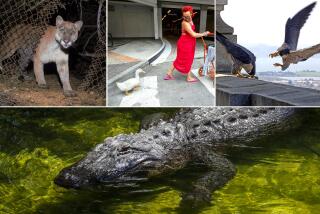San Diego Zoo joins a heck of an effort: to save the Tasmanian devil
- Share via
SAN DIEGO — The San Diego Zoo has joined a long-odds international effort to save one of nature’s tough guys: the Tasmanian devil.
Although possessed of sharp fangs, a powerful jaw and a carnivorous personality, the devil is on the verge of being wiped out by a rare and contagious form of cancer on its home island of Tasmania off the coast of Australia.
Wildlife officials Down Under, watching in horror as the devil population moves rapidly toward extinction, decided that a public relations effort was needed to raise public awareness about the marsupial’s plight.
In October, four devils arrived at the San Diego Zoo on long-term loan from the Taronga Western Plains Zoo in Australia.
In December, four more arrived at the Albuquerque Bio-Park. The eight are thought to be the only Tasmanian devils in the U.S. More loans are under consideration.
The loans are aimed at “expanding global awareness and increasing the potential for fundraising” for the Save the Devil campaign, a Tasmanian official said during the unveiling in San Diego.
An Australian production company has done a six-part documentary, “Devil Island,” about the Tasmanian devil. The series has already been shown in Australia, France and the United Kingdom.
And this week, the San Diego Zoo announced it is contributing $500,000 to the Save the Devil effort, in particular to underwrite the work of conservation geneticist Catherine Grueber at the University of Sydney.
That the devil is in such dire straits is an oddity. The size of a small dog, the devil is tough and fearless and has a screech described by Tasmanians as bone-chilling.
The devil eats both carrion and fresh meat and is said to have killed small kangaroos. The species also proved highly adaptive to changes in its environment in the last century, as well as highly reproductive.
But cancer has now wiped out an estimated 90% of the devils on Tasmania, which is part of Australia.
The sickness, discovered in 1996, is spread through contact between devils. The devils are known for biting and scratching each other, especially during eating and mating.
Researchers in Australia had hoped to find a way to inoculate the remaining devils from the cancer. But the rapid spread of the fatal sickness has outpaced the scientific advance.
“It’s really stumped all the medical folks, who hoped to find a cure, an inoculation, whatever,” said Bob Wiese, chief life sciences officer for San Diego Zoo Global, who returned from Tasmania in late February.
As a result, preservationists are now banking on a fallback strategy: Nurture colonies of cancer-free devils and then relocate them to the main devil habitat area in Tasmania once the population there is wiped out. The “insurance” colonies are at an isolated part of Tasmania and also on nearby Maria Island.
“Ultimately the disease will wipe out devils in the wild, but these newly created disease-free populations will be used to repopulate the wild, once it’s safe to do so,” said Kathy Belov, professor of veterinary science at the University of Sydney.
In San Diego, the four devils — Conrad, Debbie, Nick and Jake — are part of the zoo’s Conrad Prebys Australian Outback exhibit. Prebys, a construction and real estate magnate and philanthropist primarily in the areas of education and health, is a major benefactor of the zoo.
As a zoo attraction, the devil is not destined to be a headliner. It sleeps a lot and prefers to emerge at night. Its bristly fur has none of the cuddly look of that other well-known Australian marsupial, the koala.
But Wiese sees value in zoo patrons learning that the Tasmanian devil is a real animal with real problems and not just a Looney Tunes character.
In Tasmania, the devil’s catchy name and unique appearance are used to attract tourists and its image adorns all sorts of businesses.
“The devil is an important species, as well as a cultural icon,” Grueber said. “He’s got character.”
More to Read
Sign up for Essential California
The most important California stories and recommendations in your inbox every morning.
You may occasionally receive promotional content from the Los Angeles Times.













